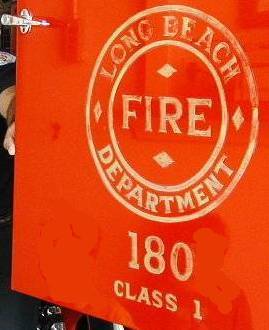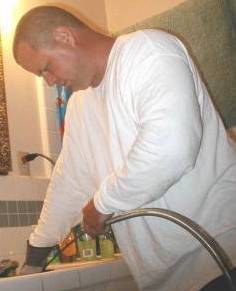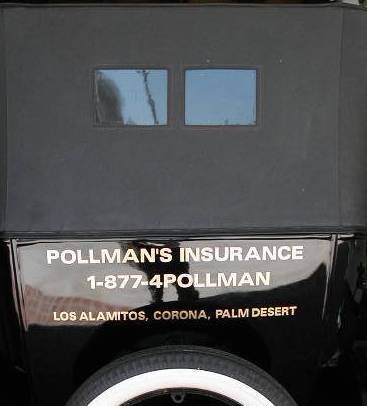News in Depth
With Updating Sound-OffCity Mgm't Advises Against Seeking Class One ISO Rank for LB Fire Protection; Councilwoman Schipske Pens Op-Ed Saying LBFD Needs Class One Rating
[With this story, LBReport.com adds a new prototype "Sound Off" feature inviting comments from taxpayers -- and elected officials. See below.]
(September 2, 2006) -- Responding to a request by 5th district City Councilmember Gerrie Schipske for a report on LB's Public Protection Classification (fire safety rating), high-level City Hall management advises against trying to upgrade LB's Class Two ranking from the independent Insurance Services Office (ISO) to Class One.
Among several grounds cited below, the memo argues at one point that the process might publicly reveal the strengths and any weaknesses in the city's water supply which wouldn't be advisable "due to Homeland Security concerns."
The eight-page memo, agendized for the Sept. 6 City Council meeting and co-signed by Fire Chief Dave Ellis, City Hall Director of Human Resources Kevin Boylan and LB Water Dept. Manager Kevin Watier and approved by City Manager Jerry Miller, says upgrading to Class One status could cost several million dollars annually for additional staff plus additional equipment and wouldn't likely lower fire insurance rates.
Management's memo notes that Class Two status is a very high ranking shared by Los Angeles [ISO's rankings range from 1=superlative to 10=no rated protection] and cites favorable reports on LBFD's operations over the past few years by separate management-retained consultants.
On April 21, 2006 LBReport.com first reported that the City of LB doesn't provide taxpayers with Class One public protection status judged by ISO, a non-government risk assessment firm used by the insurance industry. The revelation surprised and mortified some at LB City Hall; for years, LB officials had routinely stated as a matter of civic pride that LB had a Class One ISO designation that helped keep LB fire insurance rates low.

LBFD fire trucks are emblazoned with the designation "Class One." LBFD business cards also carry the designation "Class One." ISO's ranking isn't a reflection on LBFD's competence but on factors related to staffing levels, equipment, station locations, water supply, dispatch systems and the like (further below).
Then-5th district Council candidate, now Councilwoman, Gerrie Schipske pursued the issue in her successful campaign against eight year incumbent Jackie Kell...and shortly after taking office requested a management report on the matter.
Councilwoman Schipske has now penned an op-ed piece on the issue (linked in full below) titled "Why Long Beach Fire Department Needs Class One Rating." Her article says she toured six LB fire stations (not in the 5th district but "when it comes to public safety there should be no boundaries of concern") that she'd heard were most in need of repair. She says what she saw "upset me greatly...The residents of Long Beach should be angry at the condition of our fire stations, the lack of up to date equipment and staffing in our Port area and the fact that our news media failed to report these problems in depth."
LBReport.com posts extended excerpts and a link to Councilwoman Schipske's op-ed in full below. [We invite your comments to it, and on the overall issue, below.]
Management's memo notes the ISO ratings are based on three basic component areas: the Fire Dept (50%) including equipment, staffing, training, and geographic distribution of fire; the water supply system (40%), including the condition and maintenance of hydrants, and an evaluation of the amount of available water compared with the amount needed to suppress fires; and the fire alarm and fire alarm and communication systems (10%), including telephone systems, telephone lines, staffing, and dispatching systems.
Management's memo continues:
Insurers of homes and business property may choose to use ISO's Public Protection
Classifications [PPC] in calculating premiums. Insurers typically group the PPC Classes into
bands for the purpose of establishing homeowner premiums. The first band is usually
Classes 1 to 6, Classes 7 and 8 as the second band, Class 9 as the third band and
Class 10 as the fourth. Each band would have a different insurance rate; the better the
band, the lower the rate. The bands may vary from state to state and insurer to insurer.
The ISO rating is infrequently used for commercial properties . Insurers determine
commercial premiums by analyzing construction type and materials, occupancy, fire
protection (such as fire extinguishers and sprinklers) and exposure to adjacent
structures. Commercial properties are typically assigned their own PPC rating based on
these factors. The City's property insurance premiums are not based on the ISO rating
and a change in Class is not likely to have an effect on its property insurance premiums.
Management's report also discusses ISO's rating history in LB, disclosing specific areas in which ISO recommended improvements over thirty years ago...and sheds light on the mystery of how the civic mythology of LB's "Class One" ISO rating likely began:
According to obtainable documents, a physical audit of Long Beach was conducted by
the ISO in 1972. The audit assigned deficiency points to conditions that deviated from
predetermined ISO standards . The deficiency points assigned depend upon the importance of the item and the degree of deviation, as determined by ISO. The total number of deficiency points is charged against a municipality, which then determines its relative classification.
In 1972 the ISO noted a number of recommendations for improvement including:
- Increase staffing on all fire apparatus to 5 persons for both engine companies
and ladder trucks. (ISO stated that a minimum of 6-person engine and truck
companies was considered standard staffing, although this is actually rare .)
The City maintains 4-person staffing on its engines and trucks . Increasing
staffing on all rigs to 5 would increase annual costs by at least $8 million since
three shifts must be maintained at all times.
- Add three fire trucks providing a total of seven fire trucks within the City.
The City currently maintains only four trucks citywide. Adding three trucks would
cost $5.1 million annually. Staffing these trucks with 5 persons would add an
additional $2 million a year.
- Water distribution system should be upgraded in certain areas.
The Water Department already has an on-going strategy and long-range plan for
water pipe main replacement. Accelerating that schedule or changing priorities
would be costly and could result in water user rate increases in order to finance
the changes.
In addition, due to Homeland Security concerns, it is not advisable that strengths
and any weaknesses of the City's water supply and distribution system be
readily obtainable by the public. The ISO report would be made available
nationwide. The City's insurance underwriters are, of course, afforded any
information they require to provide sufficient property and liability coverage and
determine the premium cost.
- Building code amendments to be implemented to improve life safety. Since the 1972 audit, the City of Long Beach has been nationally recognized in the industry as a leader in building protection codes. In addition, the City's active
Code Enforcement Program has been very successful in the past few years in
ensuring compliance in neighborhoods. The 1972 audit assessed the Fire Department only 376 total deficiency points, the
Water Department only 98 deficiency points and 126 deficiency points were accessed due to weather conditions for a total of 600 points for the City. A Class 1 rating does not exceed 500 deficiency points and a Class 2 is from 501 to 1,000 points...Even though the City of Long Beach was assessed a Class 2 rating, the Fire and Water
Department's portions were within the Class 1 category. Apparently it was at this juncture that the departments began to utilize the Class 1 identification on a department basis.
It should be noted that since the original physical audit in 1972, a number of new
services, apparatus, and equipment have been added to the Fire Department
(Department), in addition to the Department's increased firefighting capability. For
example, the development of the Paramedic Program, the transfer of Lifeguard services
into the Marine Safety Division from the Department of Parks, Recreation and Marine,
the construction of a new state of the art Emergency Communication and Operations
Center (ECOC), fire stations, Urban Search and Rescue Program and a Basic Life
Support (BLS) transport system have been implemented. The Department was also
able to achieve its long time goal this fiscal year of having a paramedic at every station
at all times, except the airport and boat stations which are specialty sites . ISO does not
even consider many of these items when conducting an audit or physical survey,
instead only focusing on fire suppression capabilities.
The Department, along with departments nationwide have expanded rescue and
disaster service capability. The Department has been able to recently upgrade its fleet
in the past year; ten new engines, two ladder trucks, a rescue boat, two airport crash rigs, and a large Urban Search and Rescue (USAR) unit, among other vehicles, were placed into service. In the coming year, the department will place seven new Rescues (ambulances) and three Multi-Casualty Incident (MCI) units into service along with two
new Rescue boats in early FY 08 . All this equipment improves reliability, speed and
appropriateness of emergency response.
However, there is a need for many fire facilities to be replaced, repaired and/or
relocated . A separate report on public safety facilities has been transmitted to the City
Council.
LBReport.com posts a link to management's memo in full below.
For her part, Councilwoman Schipske -- who pursued the issue of Class One Public Protection status during her successful campaign to unseat former ELB incumbent Jackie Kell -- writes in an op-ed piece (emailed to several LB media outlets and posted in full below on LBReport.com) why she favors pursuing Class One status from the ISO, an independent firm providing ratings commonly used in the insurance industry.
Councilwoman Schipske writes that she recently toured LB fire stations 7, 9, 10, 11, 12 and 20...which aren't in the 5th Council district "but when it comes to public safety there should be no boundaries of concern." She says she toured "these specific fire stations because I heard they were in the most need of repair. What I saw upset me greatly" and after citing specifics, says LB residents "should be angry at the condition of our fire stations, the lack of up to date equipment and staffing in our Port area and the fact, that our news media failed to report these problems in depth."
Councilwoman Schipske's op-ed continues:
What is keeping Long Beach from being rated a 1 like the other 10 departments in California? Admittedly, a Class II rating is not "bad" in a system that rates I as being the best fire protection, to 10 being no protection at all. A Class II does not impact fire insurance premiums as does a higher number. In fact, ISO staff indicates that Long Beach has a lower loss experience than many other Class II communities.
So what’s all the fuss? Rating systems and industry accreditations provide measurements to assist City Councils make budgeting decisions.
If ISO is to be believed, many fire departments work hard to improve their [ISO rating] and take pride in their achievement. More importantly, fire departments use the [rating] as a budgeting and planning tool for justifying expenditures and improvements; in building a new fire station or to help determine the location of a new station; in buying or upgrading equipment; and in increasing staff or training of staff...
Concurrently, the Commission of Fire Accreditation International (CFAI) which grants accreditation to fire and emergency service agencies upon the successful completion of an in-depth self assessment and on-site evaluation, works with ISO to correlate the rating and accreditation systems. While the ISO rating only focuses on "fire suppression" capabilities, the process of a CFAI accreditation allows a fire department to assess the overall management and capabilities of a department that does more than just put out fires. The City Council needs these planning tools to make certain it is providing the financial support needed for its fire department.
Should the City not pursue a Class I rating from ISO, it must seek CFAI [Commission of Fire Accreditation Int'l] -- a fact borne out in the $170,000 study completed in 2005 by Tri-Data for the Long Beach Fire Services. The Tri-Data study concluded that the Fire Department response times were "well above the Commission of Fire Accreditation International (CFAI) recommendations and should be reviewed to determine the cause." Had Long Beach gone through the accreditation process with CFAI, it could have taken steps earlier to fix this problem or risk not becoming accredited.
The Long Beach Fire Department is so critical to our city and our port. I have requested that the City Manager provide the City Council with information concerning both the [ISO rating] for Long Beach and CFAI accreditation because I believe we owe it to our residents and our firefighters to find out what the City Council needs to do to make certain that our First Class Fire Department gets the support it needs to become a Class I fire response jurisdiction.
To view Councilwoman Schipske's op-ed in full, click here.
City management also recommends against seeking accreditation from the Commission on Fire Accreditation International. Management's memo states in pertinent part:
[CFAI accreditation] is an excellent tool for those agencies that have not previously performed
any self-assessments or participated in audits and/or optimization studies . Since Long
Beach has recently participated in numerous such evaluations and studies and has
developed a strategic plan, this information has already been obtained and synthesized
and included in the City's budget in the form of performance measures within the FOR system.
The issue of facilities is being addressed separately. Additionally, the recently
discussed ballot initiative proposed to fund service priorities of an additional truck
company, addition of a fifth person to the trucks, and additional resources for disaster
preparedness planning . These priorities were determined as a result of the TriData
Study and input from our stakeholders.
Management concludes:
The ISO headquarters in New Jersey was consulted as to the advantages of requesting
a physical audit and reevaluation of the City . Senior ISO officials recommended against
a physical audit due to the City's current excellent Class 2 rating . In fact, ISO officials
stated that there may be no advantage in requesting a physical audit and that the City
has an excellent rating .
The Insurance Services Office rating is only one of a number of ways to analyze the
effectiveness of fire departments throughout the country. A number of reports and
documents, such as NFPA 1710, and independent consultant reviews are used to
evaluate the quality and effectiveness of fire departments and their service to the
community.
The Long Beach Fire Department prides itself on its commitment to exceptional
firefighting performance, emergency medical services, marine safety, fire prevention,
training, emergency and disaster preparedness and public education. The Water
Department is similarly an outstanding leader in the industry and is considered an
exemplary example of a municipal utility .
It is recommended that the City not request a physical audit from the Insurance
Services Office (ISO) nor start the self-assessment process for the CFAI. The purpose
and goals of these two organizations has been fulfilled over the last thirty years through
audits and optimization studies and now through program budgeting and the FOR [city management's "Focus on Results"]
program. FOR requires continual self-evaluation and quality improvement since
performance results are publicly communicated .
The time and expense of participating in the ISO and CFAI programs are unnecessary
since they are redundant to recent and continuing activities. However, it is
recommended that the City register with CFAI in order to receive any information
provided by them.
To view management's memo in full, click here.
Developing.
Your comments on city management's recommendation, and Councilwoman Schipske's op-ed and agendized item, are welcome. To email us, click mail@lbreport.com. We'll post substantive responses as received.
[Our standard publication rules apply; your robust opinions are welcome; avoid attributing views to third parties; we reserve the right to edit everything and please include your name and a telephone number (not for publication) where we can reach you.]
Return To Front Page
Contact us: mail@LBReport.com
|

Alford's English Gardens Beautifies Area Homes. Learn More, Click Here
 Mike & Kathie Kowal know Los Cerritos, Bixby Knolls, Cal Hts. and beyond. Click to learn more Mike & Kathie Kowal know Los Cerritos, Bixby Knolls, Cal Hts. and beyond. Click to learn more

DrainPros: Unclog Drains + Full Service Plumbing, Locally Owned Pros. Info, Click Here

Wedding Entertainment Planning Is His Specialty. Bill Lovelace Delivers Personalized, Wedding Event Services. Get Info, Click Here

Preserve Your Family's Most Precious Photos and Videos on DVD. Click For Info

Carter Wood Floors, a LB company, will restore your wood floor or install a new one. Enhance your home. Click pic.
|










